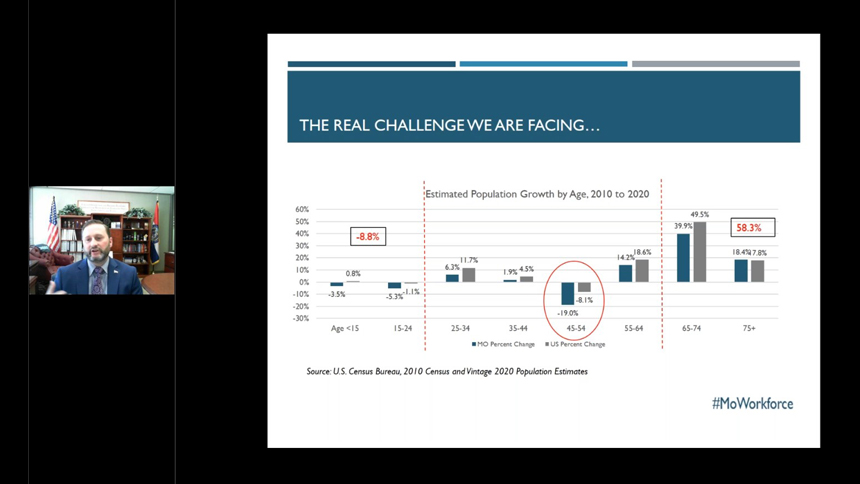Tackling workforce issues through training & improved access

Nearly every employer is facing significant challenges in finding enough skilled workers to meet both their current needs and their desire for growth. The shortage of employees has been exacerbated by the COVID-19 pandemic, but the underlying issues have existed for several years – and while there is not one fix, this shortage can be addressed by expanding the talent pipeline and increasing accessibility for those not currently in the workforce.
That was the message from Dr. Mardy Leathers, director of the Missouri Office of Workforce Development, during an all-virtual edition of the Chamber’s Inside the Issues series on January 20.
Leathers presented federal population data that demonstrated the demographic hurdles facing Missouri, and the rest of the country. The state’s population aged 45-54 dropped by 19% between 2010 and 2020, while the population aged 65-74 increased by 40%. And the youngest adult generations are not large enough to fill the gap; the portion of the population younger than 25 also decreased in the last decade.
One of the most impactful way to address the workforce shortage is to remove barriers to employment for more people around the state, including lack of access to skills training. In a 2020 survey of Missouri employers, half said the biggest barrier to expanding employment at their business was a shortage of workers with the right knowledge and skills.
The needs are particularly acute in certain industries where skilled workers are a priority. Missouri has seen more than 27,000 job postings for health care practitioners, including registered nurses, just since the start of 2021, as well as 26,000 postings for computer- and IT-related job openings.
One way the state is looking to address that skills shortage is through the Fast Track Workforce Incentive Grant program. Created in 2019, Fast Track encourages adults 25 or older to pursue a certificate, degree or credential in a high-need industry. Participants must be below a certain income threshold and cannot hold a bachelor’s degree.
Southwest Missouri has been the leader in utilizing the program since its inception – with Ozarks Technical Community College and Missouri State University both in the top five of participating institutions .
But there are some challenges with the structure of the program that have prevented the ability to realize its full potential. One such challenges is a sunset provision that creates uncertainty about future funding and a provision that converts the grants into interest-bearing loans if participants don’t meet specific criteria after completing the program.
Leathers said employers should reach out to lawmakers if they feel changes to the program would help increase access. “If there are opportunities to do things to make the program more accessible, we absolutely want to look at that,” he said.
In addition, Dr. Leathers pointed to the need to improve access to childcare, which has disproportionately affected women trying to re-enter the workforce post-pandemic while a significant number of childcare providers have shut down permanently.
While the data may be discouraging, Leathers said it’s meant to help dissuade people from thinking that all the workforce issues are a direct result of the pandemic.
“This was happening before the pandemic, although it’s been exacerbated by the pandemic” he said. “The death rate is higher than the birth rate nationwide. We have a labor participation problem, especially connected with minority populations and education levels. Until we address those issues, we will continue to have this problem.”
Thank you to Neale & Newman for sponsoring this event!
If you missed the event or want to refresh your memory, check out the video below!

